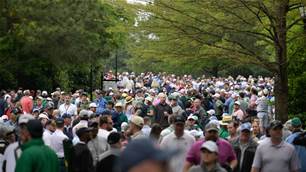You’ll have heard before now that today’s professionals play a “different game” from the rest of us mere mortals.
They always have, to an extent. But not as much as they do today, a fact that was cruelly underlined when your ever-so humble correspondent teed-up in the pro-am preceding the recent World Cup at Kingston Heath. In fact, “pro-am” is misleading, as my teammates were Belgian Nicolas Colsaerts, my fellow Golf Australia contributor Mike Clayton and LPGA Tour player Su Oh. I was actually competing in a “pro-pro-pro-am.”
Anyway, it turned out to be a fascinating day on what is surely one of the game’s greatest venues. Fascinating and eventually depressing. Let me explain, using the contrasting ways we all toured the course to make my point.
Su played the 7,300-yard (6,675-metre) layout in championship condition, on a windy day, and managed it pretty well, which just goes to show that a 6,500-yard (5,900-metre) course is way too short for a women golfer of her class. Yes, 7,300 was too long, but that is as close to her ideal mark as is 6,500 – 6,900 yards is about right. Don’t hold your breath though. Playing courses at lengths designed to properly challenge the best pros, the LPGA would not have too many 62s, 63s and 64s about which to brag. On a longer course, 69 would become a really good score.
As for the hacker in the group, pars were the most he could hope for on most holes. 7,300-yards is way too long for the average guy. But here’s the thing. The contrast between the three of us and Monsieur Colsaerts could not have been more marked. Okay, so it wasn’t quite pitch-and-putt for him. But it was close.
Yes, the ruling bodies tell us that “drives” on Tour are no longer than a decade ago. But all too often they are not measuring shots hit with drivers.
He wasn’t hitting more than a 9-iron to many greens and more often than not it was less than that. As a consequence, it became clear that, say, a six-handicapper cannot realistically play with a tour professional because of how far the pro hits the ball.
On the par-3 6th (normally the 5th), Su hit a hybrid club onto the green. Mike hit a 4-iron, so did I. And Nicolas used an 8-iron. What was more depressing than the disparity between those clubs was the type of shot the Belgian actually hit. Knowing the ball he was using was never going to spin much and so not “balloon” into the air, he simply smashed it towards the target.
 Seeing that, we challenged Nicolas to play a “proper” shot with a 6-iron, which he did. There is no question he has the skill and technique to correctly flight the ball in any conditions. That was obvious. But equally clear was how the ball all but precluded him from hitting the shot he wanted to hit.
Seeing that, we challenged Nicolas to play a “proper” shot with a 6-iron, which he did. There is no question he has the skill and technique to correctly flight the ball in any conditions. That was obvious. But equally clear was how the ball all but precluded him from hitting the shot he wanted to hit.
RIGHT: Thorbjorn Olesen hit a 404-yard drive 'out of the toe' during the World Cup at Kingston Heath. PHOTO: Scott Hallaren/Getty Images.
Sadly too, that was a shot he would never hit in a tournament. Why would he? For one thing, it is more difficult technically. And for another, the equipment he is using makes it all but impossible anyway. Just another example of how – at the top level – golf has lost its way. Compared with days gone by, it is no longer as interesting to watch – or play. Science has all but eliminated art.
Over the next few days I saw some things that should all be “exhibit A” in any presentation to the R&A and USGA when it comes to their ludicrous assertion that the modern ball is not going too far. Nicolas’ fellow Belgian Thomas Pieters drove within 90 yards of Kingston Heath’s 1st green, on a hole that, not so long ago, was a par-5. Denmark’s Thorbjorn Olesen struck a 404-yard drive off the 18th tee, then admitted he had hit the ball “off the toe.” And Spaniard Jon Rahm could see the 17th green after a drive that almost reached the brow of the distant hill that conceals the putting surface from 99.9 percent of tee shots.
This sort of nonsense shows no sign of abating.
Yes, the ruling bodies tell us that “drives” on Tour are no longer than a decade ago. But all too often they are not measuring shots hit with drivers. Armed with their turbo-charged balls, the best players in the game tee-off more than occasionally with their 3-woods. And let’s not get into how much time and money has been spent lengthening so many of the world’s great courses over the past 20 years or so.
Let me leave you with a last sobering thought. No sport other than golf has ever screwed with its venues in order to “protect” the equipment. Instead, they have done the opposite. It is madness, I tell you. All of it.
Related Articles

Huggan: Is McIlroy the best European golfer of all time?

Huggan: Before too long, Augusta’s mildly amusing rules gravitate to irritating













